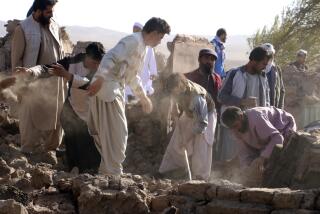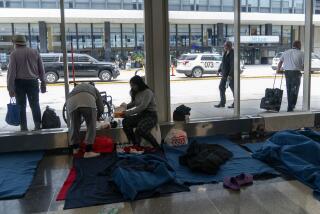Afghan War Victims Airlifted to U.S. for Treatment Under New Program
- Share via
ANDREWS AIR FORCE BASE, Md. — Cuddled in her father’s arms, 3-year-old Masuma Khan emerged from the belly of a huge military cargo plane and gingerly raised her deformed, web-like left hand damaged when Soviet warplanes bombed her house in Afghanistan.
Masuma, a shy child dressed in her native costume, is among the most recent group of Afghan war victims brought to the United States for medical treatment under a program operated by the Defense Department, private volunteers and doctors who donate their time and expertise.
After landing at this base outside Washington--only minutes before President Bush’s Air Force One touched down on the same tarmac--Masuma and nine other Afghans were taken in a bus to the base hospital. There, they sat on beds, intrigued by the small television sets at the side.
They spent one night at Andrews before scattering to hospitals across the country.
With her father, Abdullah, Masuma flew to Newark, N.J., where doctors were to operate on her hand, which healed improperly after it was burned in a fire at her home. She is expected to stay three months before returning Pakistan.
Other compatriots went to Chicago, Wilmington, Del., Columbia, Ohio, Jamestown, N.Y., Baltimore, and Jacksonville, Fla.
Said Mir, 22, who walks on crutches as the result of a gunshot wound he suffered two years ago, might have to undergo a bone graft in Flint, Mich., his destination. But simply arriving in the United States buoyed his spirits.
“I feel nice,” the Dari-speaking Mir said through an interpreter as he sat down to a meal of chicken, potatoes and carrots, served with plastic utensils that some refugees found unnecessary.
Since the Afghan airlift began in March, 1986, 825 wounded Afghans have been flown out of neighboring Pakistan for treatment in the United States, Europe, Japan and Egypt. About half have come to the United States.
“I think it’s really been a successful program,” said Rep. Bill McCollum (R-Fla.), who worked on the legislation that set up the program.
The airlift works in conjunction with the Pentagon’s use of military transport planes to fly surplus goods into Pakistan for delivery across the border to anti-communist rebels in Afghanistan.
The planes deliver supplies and then, on their return, are loaded with injured Afghans who are assisted by military medical teams.
About $10 million was allocated to the Pentagon’s humanitarian office for the program in the 1989 fiscal year, an amount that is expected to be duplicated in the coming year.
The work of finding hospitals and families to care for the wounded Afghans falls to the Intergovernmental Committee for Migration, an international, nonpolitical group that deals with refugees. The group has a contract with the U.S. government to run the Afghan program.
Patients are carefully screened and must meet specific criteria. They must be war-wounded Afghan refugees who cannot get the treatment they need in Pakistan and who do not suffer from communicable diseases. They generally need reconstructive or other complicated surgery.
Fran Sullivan, who handles the Afghan account at the committee, said hospitals in the United States sometimes use the Afghans as “teaching cases” because doctors do not often see the kinds of war wounds suffered by the refugees.
Typically, an Afghan receives up to $35,000 in free medical care in the United States.
To place the wounded at hospitals and in homes for their rehabilitation, the committee seeks help from groups formed to support the Afghan rebels and from members of Congress interested in the issue. They include Sens. Claiborne Pell (D-R.I.), Gordon J. Humphrey (R-N.H.) and Rep. Charles Wilson (D-Tex.)
During convalescence, the Afghans stay with local residents, often Muslims who understand their cultural needs, such as dietary rules against eating pork.
The big problem facing the committee these days is the shortage of hospitals that will agree to take the patients, Sullivan said. There are roughly 450 Afghans in Pakistan who have been approved for the program and are awaiting placement.
One reason for the backlog is the decline in interest in the Afghanistan issue in the United States, Sullivan said.
Since the Soviets withdrew their troops from Afghanistan last year, he said, many Americans say, “Wait a minute. I thought that war was over.” But the U.S.-backed guerrillas are still battling the Soviet-supported Afghan government of Najibullah.
Once they have been treated, some Afghans are not keen to return to Pakistan, where they typically must rejoin the 3 million Afghans in primitive refugee camps along the border. Their status, however, is not changed by their stay in the United States.
BACKGROUND The program of airlifting wounded Afghans to other countries for treatment began in 1986, using military planes on their return trips after dropping off supplies in Pakistan for the Afghan rebels. Cost of the program is paid out of the Pentagon’s humanitarian office.
More to Read
Sign up for Essential California
The most important California stories and recommendations in your inbox every morning.
You may occasionally receive promotional content from the Los Angeles Times.










